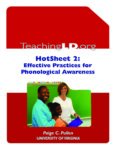Effective Practices for Phonological Awareness
Phonological awareness has received a great deal of attention in recent years. As a result, a plethora of information is available to teachers who wish to incorporate phonological instruction into their curriculum. Some of the resources and strategies provided for teachers are based on sound research, but others are not. The purpose of this guide is to define phonological awareness and provide a brief summary of the more and less effective practices for implementing phonological awareness instruction.
What is phonological awareness?
Phonological awareness is an understanding of the sound structure of language; it is the knowledge that the speech flow is composed of smaller units (i.e., words, syllables). Phonological awareness comprises four levels: word, syllable, intra-syllabic (or onset/rime), and phoneme. The term phonological awareness refers to the awareness at each of these levels. Phonemic awareness refers to the ability to detect and manipulate sounds at the phoneme level. Competence in phonemic awareness is critical to the acquisition of decoding skills.
Children acquire facility with phonological skills beginning with larger units (words) and moving progressively to smaller units, finally gaining competence at the phoneme level. For example, a child may learn to blend two small words to make a compound word, then progress to the ability to blend syllables, then onsets and rimes, and lastly, phonemes. In addition to blending, phonological awareness includes the abilities to detect, match, segment, rhyme (recognize and generate), and manipulate sounds in language.
Why is phonological awareness important?
Research has demonstrated clearly that one result of phonological awareness instruction is improved acquisi- tion of early decoding skills and higher reading achievement. In prediction studies, phonological awareness has been isolated as the most robust predictor of early literacy skills, followed by knowledge of letter names.
Although many factors predict later reading achievement (e.g., mother’s level of education, socio-economic status), little can be done in the classroom to address these issues. However, teachers can make a difference in a child’s future reading achievement by providing instruction in phonological awareness. Improvements in PA result in improvements in reading skills, particularly when the instruction is paired with letters.
Phonological Awareness Facts
- Phonological awareness is necessary, yet not sufficient for successful acquisition of decoding and spelling skills.
- Blending and segmenting phonemes are the two phonological awareness skills most useful for the acquisition of decoding skills.
- More phonological awareness instruction does not mean that it is better instruction, and more is not necessary.
- The relationship between decoding skills and phonological awareness is reciprocal; PA is necessary to acquire decoding, but as decoding skills improve, so do phonological skills.
- Phonological awareness is a reliable predictor of later reading achievement.
- Early intervention can result in improvements in phonological awareness.
Phonological Awareness
 View PDF: "Phonological Awareness"
View PDF: "Phonological Awareness" Paige Pullen describes what phonological awareness is and what is known about effective practices.